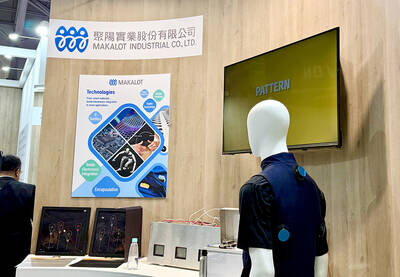Deputy Minister of Economic Affairs Tseng Wen-sheng (曾文生) yesterday agreed to reassess the metrics used in deciding the nation’s feed-in tariff (FIT) for renewable energy.
Following a heated public hearing with solar power industry representatives in Taipei, Tseng said that the Ministry of Economic Affairs (MOEA) could improve its assessment of the FIT, which it had based on a report that the Taiwan Institute of Economic Research (TIER, 台灣經濟研究院) had been commissioned to conduct at a cost of more than NT$20 million (US$649,140).
The assessment metric relies on receipts and does not fully reflect the true cost of solar projects, industry representatives said yesterday, with many tipping their hat to protesters in Paris by donning yellow reflective vests.
“Moving forward, the ministry will hold separate public hearings to iron out conflicting views on the processes for selecting solar project receipts,” Tseng told reporters on the sidelines of the hearing, following criticism that the TIER report was flawed and based on questionable data.
“Still, many are calling for a FIT cut as the cost of solar energy and its setup costs drop around the globe,” Tseng said.
Falling solar energy prices were the result of China’s so-called “May 31 New Policy,” which has exacerbated the dumping of solar modules worldwide, while prices have remained relatively unchanged in Taiwan, PV Generation System Association head Eric Kuo (郭宣甫) said.
While money could be saved by using Chinese imports, the government should support locally made products, Kuo added.
A stable FIT would help local producers weather the price slump, which should subside in the near future, Kuo said.
Separately, Star Energy Corp (星能), a subcontractor for onshore deliverables, said at a public hearing for the wind energy industry that the FIT cut had begun to cause foreign developers to consider pulling out of Taiwan.
The government’s cut is too severe and does not reflect the costs of meeting Taiwan’s higher construction expenses due to climatic and geological conditions, in addition to local content requirements, foreign wind energy developers said.
While Taiwan has proposed to cut the FIT by 12.7 percent to NT$5.106 per unit over the next 20 years, France is offering rates equivalent to between NT$5.3 and NT$7.2 without local content requirements, Wpd Taiwan Energy Co Ltd (達德能源) said.
The ministry’s plan to cap the government’s purchase of offshore wind-generated energy to 3,600 operating hours per year would also deter companies from deploying the latest turbine technology, Wpd Taiwan said, adding that a cap of 72,000 operating hours per year should be set for the next two decades.
Orsted A/S said that the rate cut, implemented at such an early stage, would prevent Taiwan’s offshore wind projects from maturing and delivering clean energy at low prices once they enter the auction bidding phase.
A period of development helped by a stable FIT is required before offshore wind energy becomes cheaper, offshore wind energy developers said.

Shares in Taiwan closed at a new high yesterday, the first trading day of the new year, as contract chipmaker Taiwan Semiconductor Manufacturing Co (TSMC, 台積電) continued to break records amid an artificial intelligence (AI) boom, dealers said. The TAIEX closed up 386.21 points, or 1.33 percent, at 29,349.81, with turnover totaling NT$648.844 billion (US$20.65 billion). “Judging from a stronger Taiwan dollar against the US dollar, I think foreign institutional investors returned from the holidays and brought funds into the local market,” Concord Securities Co (康和證券) analyst Kerry Huang (黃志祺) said. “Foreign investors just rebuilt their positions with TSMC as their top target,

REVENUE PERFORMANCE: Cloud and network products, and electronic components saw strong increases, while smart consumer electronics and computing products fell Hon Hai Precision Industry Co (鴻海精密) yesterday posted 26.51 percent quarterly growth in revenue for last quarter to NT$2.6 trillion (US$82.44 billion), the strongest on record for the period and above expectations, but the company forecast a slight revenue dip this quarter due to seasonal factors. On an annual basis, revenue last quarter grew 22.07 percent, the company said. Analysts on average estimated about NT$2.4 trillion increase. Hon Hai, which assembles servers for Nvidia Corp and iPhones for Apple Inc, is expanding its capacity in the US, adding artificial intelligence (AI) server production in Wisconsin and Texas, where it operates established campuses. This

US President Donald Trump on Friday blocked US photonics firm HieFo Corp’s US$3 million acquisition of assets in New Jersey-based aerospace and defense specialist Emcore Corp, citing national security and China-related concerns. In an order released by the White House, Trump said HieFo was “controlled by a citizen of the People’s Republic of China” and that its 2024 acquisition of Emcore’s businesses led the US president to believe that it might “take action that threatens to impair the national security of the United States.” The order did not name the person or detail Trump’s concerns. “The Transaction is hereby prohibited,”

Garment maker Makalot Industrial Co (聚陽) yesterday reported lower-than-expected fourth-quarter revenue of NT$7.93 billion (US$251.44 million), down 9.48 percent from NT$8.76 billion a year earlier. On a quarterly basis, revenue fell 10.83 percent from NT$8.89 billion, company data showed. The figure was also lower than market expectations of NT$8.05 billion, according to data compiled by Yuanta Securities Investment and Consulting Co (元大投顧), which had projected NT$8.22 billion. Makalot’s revenue this quarter would likely increase by a mid-teens percentage as the industry is entering its high season, Yuanta said. Overall, Makalot’s revenue last year totaled NT$34.43 billion, down 3.08 percent from its record NT$35.52